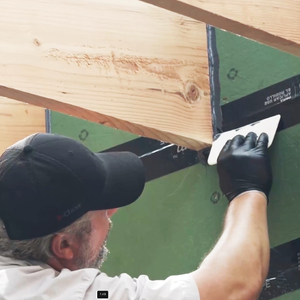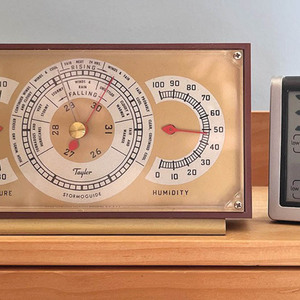I rarely use corded drills anymore, but I had to bore holes for several locksets today. I pulled out my Dewalt corded drill and the whole time I’m using it, I’m thinking that it doesn’t really seem all that powerful.
For the sake of comparison, I drilled a bunch of holes (using an 1 1/4 spade bit)with a Ryobi 4.5 amp drill and then again with the Dewalt 6.0 amp drill. I really forced the bit to purposely put a high load on each drill. Much to my surprise, the Ryobi (about $30.00) significantly outperformed the Dewalt (about $70.00).
Obviously, amps is not the complete story. There was a discussion recently about reciprocating saws and amp ratings. Most agreed that amps is not always a true indicator of power. And there you go.
Still, I’m not sure that the Ryobi is a “better” drill. Both drills were starting to smell like something was burning, but the Ryobi smoke was a little stronger. It may not last, but for the price, it’s a nice backup.
When the Ryobi finally goes up in smoke, I’m going to replace it with a better drill, but probably not a Dewalt. Even if the new Dewalts produce more power, I’m just not crazy about its ergonomics. What drills do you folks like?
-Don


















Replies
Milwaukee
Milwaukee magnums
Life is not a journey to the grave with the intention of arriving safely in a pretty and well preserved body, but rather to skid in broadside, thoroughly used up, totally worn out, and loudly proclaiming
WOW!!! What a Ride!
Forget the primal scream, just ROAR!!!
sounds like the DW has intrenal problems...
Life is not a journey to the grave with the intention of arriving safely in a pretty and well preserved body, but rather to skid in broadside, thoroughly used up, totally worn out, and loudly proclaiming
WOW!!! What a Ride!
Forget the primal scream, just ROAR!!!
Don
Picked up this one a couple of months ago. I don't know if the deal is still available. Plenty of power.
http://www.tylertool.com/mi021vsrmadr.html
Mike (from bikefest)
I have a Milwaukee 3/8" electric that is very nice and very powerful. It even came with a sticker on the housing warning about torque.
"When asked if you can do something, tell'em "Why certainly I can", then get busy and find a way to do it." T. Roosevelt
buy a 1/2 millwaukee. be sure your health insurance is paid up.if the bit hangs up,it's you or the drill.my drill always wins,haven't broke a wrist yet,but...... larry
hand me the chainsaw, i need to trim the casing just a hair.
What is the chuck size and rpm rating of the two drills? Like said amps ain't everything.
Ahh....the pleasant smell of Ryobi smoke. *chuckle*
When it comes to drilling speed, what seems to be most important is speed.
I have a 5 amp 3,000 rpm Makita specifically for sinking deck screws. This is too fast for many purposes and too slow for fast wood drilling, but it's about perfect for putting in screws. A 4" Torx-head screw will be smoking at the tip when it's driven into doug fir, and if backed out and sunk again the screw will be so hot it easily strips out even if started in a new hole. It's really too fast for good screw control (pardon the expression.
The Dewalt 2,500 rpm, 6 amp drill is the general purpose drill for metal drilling, large diameter spade bits, paint mixing and larger deck screws. The speed and torque on the low end is nearly perfect for good control when sinking most screws. Like most Dewalt tools it's tough, but feels a little clunky. Having been around 4 different Dewalts just like it, they have all lasted much longer than they should have with the roughest of use.
Then there is nice and light 3 amp Makita turning 2,200 rpm specifically for drilling pocket screws, shelf pins, counter sinks and other light duty repeditive drilling. I love the way it fits the hand and how easy it is to use.
These three drills are similar, but each is only ideal for a small range of uses.
A 4,000 rpm drill would speed up repetitive wood drilling with larger twist bits.
Beer was created so carpenters wouldn't rule the world.
Thanks for the input. I was looking at the Milwaukee since I already have some of their tools and I like them. It's good to hear that their drills are well-liked too.
As for RPM, the Ryobi is rated at 0-1400 and the Dewalt at 0-2500. That may explain why the Ryobi did better with a spade bit. I'm assuming it's geared lower and a spade bit requires torque rather than speed.
-Don
Milwaukee for the serious stuff .
Spheramid Enterprises Architectural Woodworks
I have irriatable Vowel syndrome.
old souix drill motors
Milwaukee, Milwaukee, Metabo and Thor (over 60 years old and still going strong ;-) )
I have the D handle Thor in 5/8...
IIRC thety were made by Grumman..
Life is not a journey to the grave with the intention of arriving safely in a pretty and well preserved body, but rather to skid in broadside, thoroughly used up, totally worn out, and loudly proclaiming<!----><!----><!---->
WOW!!! What a Ride!<!----><!---->
Forget the primal scream, just ROAR!!!
Thanks! It was the only electric drill my dad ever owned. He was a roofer-tinner and gave it a pretty good workout, as have I. I really like that tough old piece of aluminum.
As has been said , it depends what the job is at hand .
Different drills have different uses .
However , its hard ro beat a dual speeded drill in half inch chuck size with a varible trigger for powerful jobs. Thats what I would have chose to do the job you were doing . Ive got two in that size that also are hammer drills which again is another nice feature .
To further choose the right drill for that job alone , I would have picked up the Milwakee that has a lower setting of 300 rpms. Power plus setting that doesnt mind hitting Oak if you dont . I prefer a slow and powerful drill for that application. Thats far out of the cordless feild of power except in 24 volt. Even then I wonder if a 24 volt would stand beside it . I dont own a 24 volt.
Point being is that you wouldnt drive screws with a 24 volt and probably wouldnt mix SR mud with one either . Thats why we have so many different types of drills. For pre drillling hinge screws its hard to complete with a 1/4 inch corded drill, so there ya go. I have 5 Makita 1/4 inch drills , and several 3/8s to 1/2 inch in the same brand of corded drills . Makita doesnt seem to ever die in my shop. They are basically simple drills that I have that have provided heavy service for a number of years. Drum roll please ,,................... I have a Makita 1/2 inch drill that saw daily use for 15 years that stayed connected to a mud bit . It is 30 years old and will still whip up a 4 gallon box of joint compound in a five gallon bucket. The cord frayed years ago and had been replaced three times . I challenge any cordless drill to that record. I have another drill that is its match exactly that is several years newer but is still considered an old drill at roughly 15 years old. Its used for multipurpose wiring jobs and boring locksets and the like . This past year it was taken out of the truck tool box for a much newer Milwaukee that has all the bells and whistles I talked about above . The Makita never wore out , it just got out dated. What I really like about the newer drill other than impact is the dual range with varible speed which in a pinch can mix paint at a varible slow speed in 5 gallon buckets with out sloshing if its asked to. It will drive leg bolts seurely till the cows come home if I am with out a impact wrench.
Tim
Just for the record (and b/c I haven't heard many people mention this brand), I really like my Ridgid 1/2 hammer drill (R5010 - see link). I have used it many times under pretty tough conditions and it has held up wonderfully, and I have never seen or could not smell any smoke no matter how hard I pushed the drill.
In particular, the pulse mode is very handy, as is the "cruise control" feature when drilling in concrete of any significant depth.
http://www.ridgid.com/MenuDriver.asp?ParentID=R5010-Hammer-Drill
all Milwaukee, all the time. 24 hrs/day
"The nearest thing to eternal life we will ever see on this earth is a governmental program" -Ronald Reagan
I have the 6 amp Hitachi. very well made tool.
Second...Milwaukee...Hole Shooter
rustbucket
Another vote for Milwaukee but I'll qualify that by saying stick to the older design models. My 0234-6 5.5 amp has a lot more cajones than the 7 amp 0302-20 we have at work ............. suspect it's the gear reduction. Think the ergonomics are better in the older designs; the newer ones are longer and feel nose heavy to me.
Bucking the trend here, I cannot endorse Milwaukee drills.
IN my experience, Milwaukee drills have a few 'design glitches'. These include:
-A too-accessible trigger, which often leads to the thing turning on at the wrong time- such as when you set it down;
-A 'trigger lock' that is too often accidentally engaged when holding the drill in your left hand; and, most serious,
-A tendency, when the bit jams, to either hurt your wrist, or twist you off the ladder.
Personally, I'd rather have the motor seize up briefly, than lose control when the bit hangs up. I'm not so sure that more power is better than having a clutch!
As far as drilling efficiency, I fail to see the effect that having 'more power' has ... assuming that the minimum requirement is met.
Every material has an ideal "feed" (how hard you push) and "speed" (rpm) for drilling it. Since the work takes place at the tip of the bit, this is where tool design has it's effect. As long as the drill is providing "enough" power, it really ought not matter how big the motor is.
There are three things that DO make a difference:
- The shape of the drill can either help, or hinder, your efforts to push straight into the hole;
- The motor size, and its' controls, can make a difference in maintaining the correct drilling speed; and,
- The motor vents can help to blow chips and dust away from the hole.
I suspect that, given exactly the same feed and speed, that amp readings of power actually used will be essentially identical between makes.
Now, there are things you can do to drill "faster," but most of those things will give you a ragged hole and a toasted bit.
Were I looking for a drill, I'd probably look first at German makes; German tools, again, in my experience, have better 'ergonomics.' That is, they fit your had better, and encourage you to take a grip that will let you use the tool more effectively.
The second thing I'd look for is a speed control that was easy to read, and set.
I stress again, though, that the design of the cutting tool is where the greatest difference can be made. If you're using the same generic bits for every chore, you'll never get the results you want.
My vote goes to the Milwaukee- I have the 299-30 and it is a monster of a drill! The Newer Makitas (DP4000 series)are supposedly just as good according to a tools of the Trade magazine shootout of 1/2 inch corded drills.
When the last bits of smoke fell out of my old 1/2" AEG, I picked up a reconned Bosch 1199...it's great. I have to drill a lot of 4" holes in hardwood, the Bosch has an "anti-rotational" clutch... no hanging up so no more bruised ribs, arms, chins<G>. Works great on doors, too. Oh God said to Abraham, "Kill me a son"
Abe says, "Man, you must be puttin' me on"
God say, "No." Abe say, "What?"
God say, "You can do what you want Abe, but
The next time you see me comin' you better run"
Well Abe says, "Where do you want this killin' done?"
God says, "Out on Highway 61."
why so many 4" holes?
The pancake boxes for ceiling fans need a recessed hole...usta nearly get my arm ripped out of the socket<G> Oh God said to Abraham, "Kill me a son"
Abe says, "Man, you must be puttin' me on"
God say, "No." Abe say, "What?"
God say, "You can do what you want Abe, but
The next time you see me comin' you better run"
Well Abe says, "Where do you want this killin' done?"
God says, "Out on Highway 61."